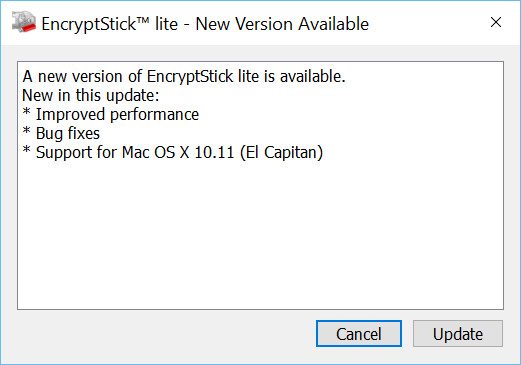


The latter is managed only (and available in an unmanaged version, too), while the previous three may be also be used unmanaged.These types of solutions are basically the same as having an encrypted, password-protected 7z file on your stick and being able to open it with 7-Zip Portable. No less than four of the drives in our roundup are manageable in this sense: the Defender 2000, the Defender F200, the CE-Secure Vault FIPS, and the DataTraveler 4000 Managed. They can even set drives so that the data partition is hidden unless the unit is in contact with a server.
#Encryptstick 6 review password
Using a server console such as BlockMaster’s SafeConsole or Imation’s ACCESS Server, your friendly IT guys-in-black can set password strength, force password changes, track logins, and the like. Most useful with fleets of drives, manageability means that the drive’s status and security characteristics may be modified by an administrator–locally, or remotely across a network or the Web.
#Encryptstick 6 review software
On the software front, an increasingly common theme for secure flash drives is manageability. And with Level 4, you add physically daunting packaging and fry the data and decrypting mechanisms if a breach occurs. Level 3 adds protection for the encrypting mechanisms and algorithms themselves. With Level 2, the encryption is supplemented by a means to reveal tampering. Level 1 involves using an approved encryption algorithm (such as AES 256). It’s not a technology, but rather a definition of what security mechanisms should do.
#Encryptstick 6 review free
Though you can certainly secure your data with a normal USB flash drive and encryption software such as the free TrueCrypt or EncryptStick, a chip is harder to hack, and to reach it means actually tampering with the drive, which is easy to detect.įIPS 140-2 (Federal Information Processing Standard, Publication 140-2), referred to above, is the government’s take on methods for securing data. (And pray you never have to get out of Dodge in a hurry.) The Secure Advantage…Īll the drives in this roundup use the 256-bit AES hardware encryption required to achieve FIPS 140-2 Level 2 certification.

Performance isn’t the main reason you buy a secure flash drive, but you might want to stick with cheaper, smaller-capacity models until the faster technology shows up. The fastest drive in this roundup tested nearly four times slower than two nonsecure USB 3.0 flash drives we included for comparison. In fact, none of the manufacturers reviewed here expect to release a USB 3.0 model until at least late this year. Unfortunately, current secure flash drive performance doesn’t match security, largely because they’re mired in the USB 2.0 past. The Apricorn Aegis Secure Key is being processed for Level 3 certification, though it is not yet certified. The Imation Defender F200 ratchets that up to Level 3. Three of the units–the Kingston DataTraveler 4000 Managed, the Kanguru Defender 2000, and the CMS CE-Secure Vault FIPS–are certified to Level 2 of the government’s FIPS 140-2 security standard. The results? As far as security is concerned, it’s all systems go. To get the skinny on the state-of-the-art in secure flash drives, we took five hardware-encrypted drives for test spins. You’ll pay a premium for the integrated security, but you can’t put a price on the peace of mind you get by knowing that your data is locked down. And what better than something that hides easily within a pocket? Secure flash drives that are only about the size of a small cigarette lighter feature robust hardware security to make them super secure.

If you’re physically transporting data you don’t want other people to see, you should be doing it on secure media.


 0 kommentar(er)
0 kommentar(er)
